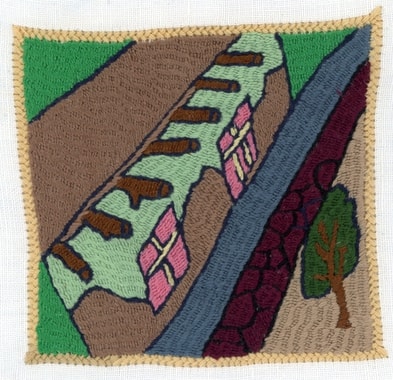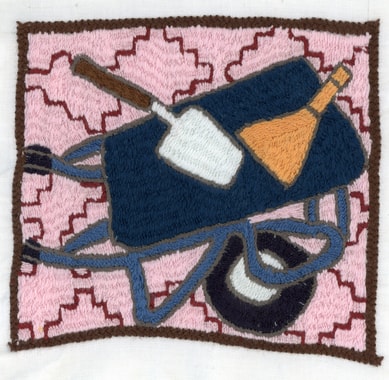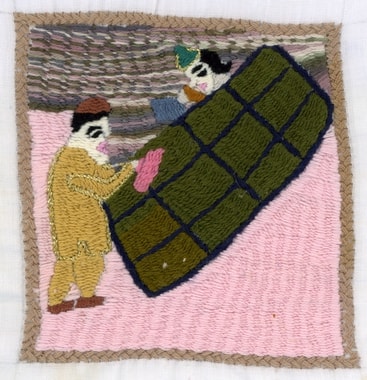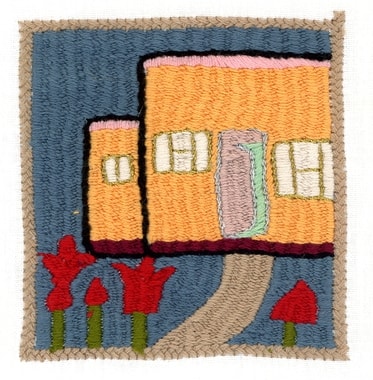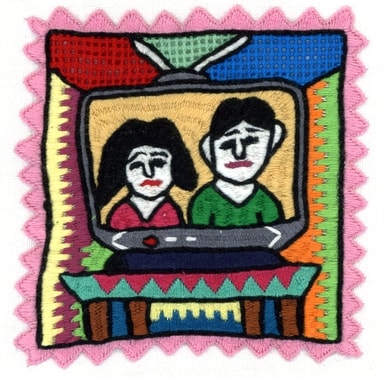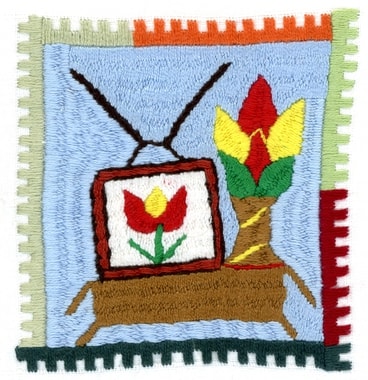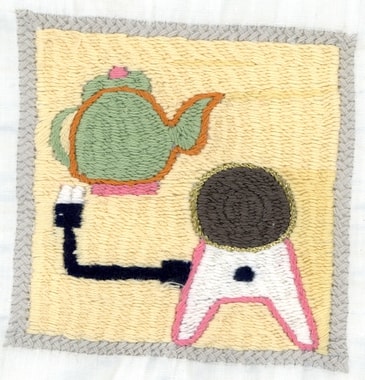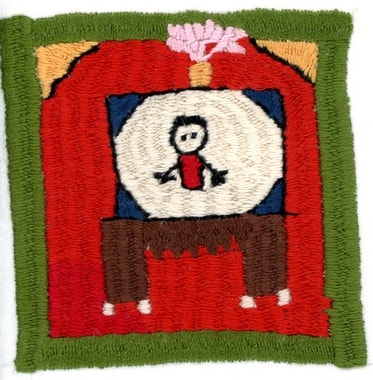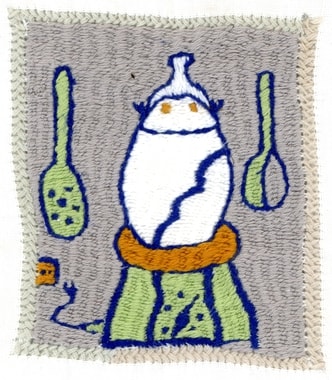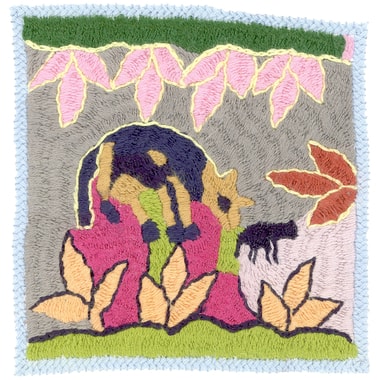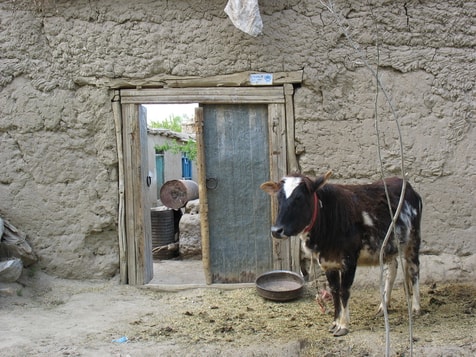Sabine’s travel report
October 2012
(completed by Pascale)
Short version of the October 2012 Travel Report by Sabine Dryander and Pascale
You can read the complete version as a pdf file (link above on the right).
The October trip was only two weeks long, shorter than the previous one, so we concentrated our work on the villages in the Shomali Plain (Laghmani) and did not fly to Herat. This time Sabine accompanied me. Because of her positive attitude, curiosity and openness as well as her hard work, she was a valuable travel companion. Her travel report will serve to present our project from a fresh perspective. I will supplement Sabine’s impressions with my more prosaic comments in the italicized passages.
The hospitable household of the Hashimi family in Kabul graciously took in Pascale and me for the two weeks of our stay. Here we assembled new embroidery packets and came up with special projects: extra jobs for selected embroiderers, on the one hand because they practiced a specific style, on the other to afford them additional financial help. Our sessions also offered a welcome respite from our day trips to the villages. We were spoiled with good food and took part in the family’s everyday routine. A lovely experience!
Our workload for the two weeks could only be completed on a strict schedule, but we also made time to travel to the silk weavers of Shaima Breshna (Azezana), and I am now very happy to have been introduced to this wonderful project.
The trips to the villages. Departure always around 6 a.m. Our first job was to pick up the completed embroideries of the past months. After our breakfast of fresh flatbread, hot tea, yogurt and honey, sometimes also fried eggs with tomatoes and onions, the first women of the village came with their embroidered cloths. In the courtyard of the houses there was ample room in one corner for collecting and appraising their work – this was the job of Pascale, Khaled and Lailuma. A few meters away, I did drawing exercises with several of the women. The idea was, if possible, to support the women in their ability to draft their own designs. All too often this preliminary work is done by others: the nephew, the husband or the sister. Our goal was to encourage the women to draw for themselves and to develop the confidence to do so. These improvised “drawing lessons” were, with the help of my translator Zahur, Khaled’s brother, set up as follows:
Short overview:
1) Looking at their embroideries:
– Which square did you design yourself? (Often I was able to say it was especially pretty.)
– Why don’t you draw the designs yourself?
– What do you like to embroider the most?
2) Tasks to find out how well the embroiderer can handle a pencil:
– Drawing a stem with leaves
– Drawing a flower
3) Observation, praise, critique:
– Creating an awareness of the shapes of leaves and flowers around us
– Looking at details
– Encouraging a close observation of nature
4) A few basic exercises:
– Shading
– Undulating lines
– Circles
– Sideways figure eight (lemniscates)
– Practicing flowing lines and muscle relaxation: Some of the women are semi-literate or illiterate and have insufficient pencil-holding skills.
– Stimulating the imagination: Undulating lines become vines, circles are the basic form for all sorts of shapes and patterns, shading can provide a possible background, etc.
5) Anyone with time and inclination is encouraged to repeat the exercises at home, perhaps drafting a design and bringing it along the following week (on payday).
I actually did get some results. It was mostly the younger women who had the nerve (or the time?) to show me their efforts. Two especially successful designs are even being embroidered.
Paydays. On the paydays, things were more calm and businesslike. In three days 21 000 € were distributed. Only if the unpleasant task of firing an embroiderer arises is the calm disturbed. Suddenly we see how difficult it is to maintain a balance between the possibility of preserving the women’s source of income and of satisfying the requirement of the project to find buyers in Europe. Fortunately there is always the alternative of creating a sponsorship!
Since the spring of 2012, there has been a donation account at the DAI for the embroidery project (called Emergency Embroidery Aid “Sticknothilfe” SNH), which I supported. Subsequently, three families of embroiderers, as well as Soraya’s family, have been receiving monthly support.
In closing I would like to report on two events:
Soraya’s embroidery did not sell because of its poor quality. To continue to employ her would have harmed the project. When she was informed of the termination of her employment, a murmur went through the group of her fellow workers. They protested that this would not be possible since she was managing on her own with two children, one of whom was disabled. She not only worked in the gardens like a man, she had even renovated her own house. I came to the following conclusion: She would no longer embroider (she doesn’t have the patience for it), but she would be supported from the Emergency Embroidery Aid Fund with 40€ per month, much more than what she would have earned with her embroideries. I hope that in the future she will be able to live without undue stress and strain.
When the delivery day for the embroideries in Kakara ended, five of the expected women had not yet shown up. We wanted to begin our return trip to Kabul, but the lady of the house pleaded with us to wait; the expected women were very poor and should under no circumstances miss their delivery appointment. Fortunately they arrived soon after.
Both cases testify to the great solidarity among the women. Even if they come from different families and other clans, they are in no way indifferent to each other’s troubles.
The best report is saved for last. For the very first time we saw three young girls on the village pathways who at their ages should have worn full cover – called tshaderi (no longer by law, but by tradition). These girls were simply wearing headscarves as they ran freely about their village. This meant that their father had given them permission to do so and shows that he had overcome the idea of “What will people think of me?” What an indescribable joy to experience such a scene!
Postscript: And just where is Sarah? People have been asking me since I returned if she is no longer involved? Of course she is, and this year she has even travelled twice to Kabul, all alone. But this time it was my turn!












